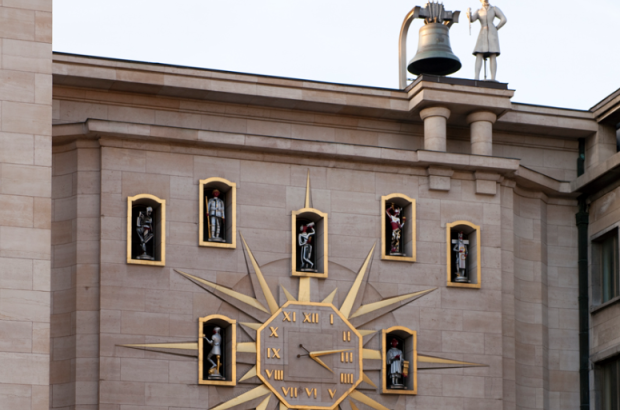- Daily & Weekly newsletters
- Buy & download The Bulletin
- Comment on our articles
Mont des Arts clock chimes again
Dating back to Brussels’ 1958 World Fair, one of the capital’s most famous sights, the Mont des Arts’ musical clock, is ringing once more.
The news follows more than six months of renovation work and the installation of an up-to-date electrical system.
Located on the rear facade of the Palais de la Dynastie, the clock’s bells make up the third largest carillon in the city, after those in the Brussels federal parliament and the cathedral.
Visitors and Brussels residents alike flock to see the "Jacquemart" at the top of the Mont des Arts carillon.
This 2.8 metre bronze statue by Henri Albada is of a top-hat wearing bourgeois from Brussels, who strikes the 1.75kg bell on the hour and half hour. Some 23 other bells are dedicated to melodies.
On the star-shaped clock, every hour is represented by a painted figurine, each of which represents a historical figure from Brussels history or folklore.
In clockwise and chronological order, you will see in the 12 alcoves: a Galois, Godefroid of Bouillon, Jan Van Artvevelde, Philip the Good, Charles Quint, Pierre Paul Rubens, the Count of Egmont, a soldier in 1790, Charlier (la Jambe de Bois), a tam-tam player, a World War One soldier, and an ordinary worker.
“This carillon is part of Brussels’ sound and visual landscape. It is a familiar landmark for hundreds of passers-by, Brussels residents and tourists every day,” said Belgium’s federal minister responsible for state buildings.
“The Mont des Arts carillon can once again resonate and, in its own unique way, tell the story of Brussels’ history and soul,” she said.
Every hour, between 8.00 and 22.00, a different musical tune is played, accompanied by the character corresponding to the hour in its niche. The highlight comes at midday, when the 12 characters perform a musical and visual display.
To mark Belgium’s three regions and languages, French, Dutch and German tunes will be played. The programme will vary every three months, and a specific tune is planned for special occasions, such as Belgium’s national day on 21 July and the end-of-year celebrations on 31 December.
The works to restore the monument began in April and have cost €167,400. Belgian carillon culture has been listed as Unesco intangible cultural heritage since 2014.
Belgium’s Building Agency explained that the original hydraulic mechanism had become obsolete and particularly vulnerable to weather conditions, such as the oil freezing in winter, leaks and burst pipes. In addition, spare parts were increasingly difficult to find.
Last year, it announced that “a more modern, environmentally friendly and reliable” electrical system has been installed. This allows the carillon to be controlled and programmed remotely and will allow people to watch the Jacquemart strike the bells and hear the chimes for many years to come.
A Jacquemart is an automaton, an animated, mechanised figure of a person. Usually made out of wood or metal, this clockwork figure strikes the hours on a bell with a hammer.
Photo: PMRMaeyaert/Wikimedia. Licensed under Creative Commons


















